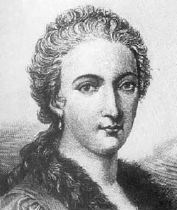

Maria Agnesi was the eldest of 21 children in a wealthy family.
Her father could provide high quality tutors for Agnesi. She showed remarkable talents, and mastered many languages such as Latin, Greek and Hebrew at an early age.
In 1738, she published a series of essays on philosophy and natural science. The volume contained 191 philosophical theses which Agnesi would defend in disputes with specially invited audiences of important international and national people who her father would invite to his
house.
She considered becoming a nun, but her father forbade it.
So Agnesi concentrated her efforts on studying religious books and learning mathematics. She was fortunate that a monk who used to be a mathematician in Rome and Bologna, arrived in Milan and became a frequent visitor to the Agnesi house.
With his help, Agnesi studied calculus, and he encouraged her to write a book on differential calculus. She wrote the book in Italian as a teaching text.
Agnesi, with her father's money, was able to arrange for the private printing of the book in her own home where she could supervise the whole operation
herself. However, she wished to obtain more input from leading mathematicians so she wrote to Riccati, and it was eventually published.
Her book contains no original mathematics by Agnesi. Rather it contains many examples
which were carefully selected to illustrate the ideas.
The book includes a discussion of the cubic curve now know as the "witch of Agnesi". It is called a "witch" because of a translation error, Colson mistaking "la versiera" meaning "rope that turns a sail" for "l'aversiera" which means "she-devil".
Pope Benedict XIV wrote to Agnesi saying that he had studied mathematics when he was young, and could see that her work would bring credit to Italy and to the Academy of Bologna. Soon after this he appointed Agnesi to the position of honorary reader at the University of Bologna. Then Agnesi was approached by the president of the Academy of Bologna and three other professors of the Academy and invited to accept the chair of mathematics at the University of Bologna. While her name remained on the rolls of the university for 45 years, she never went to Bologna.
After the death of her father in 1752, Agnesi devoted herself entirely to charitable work.
Agnesi spent all her money on this charitable work, and she died in total poverty in the poorhouse of which she had been the director.